
Another central square largely untainted by the modern day. Two of Vienna’s most prominent tourist attractions flank Maria-Theresien-Platz: the Naturhistorisches and Kunsthistorisches museums.
- Completed around 1890 as part of the Ringstrassen project
- Also home to the Maria Theresa monument
- Gorgeous during the Christmas market
- Book a walking tour* for your visit
- See also:
History and buildings
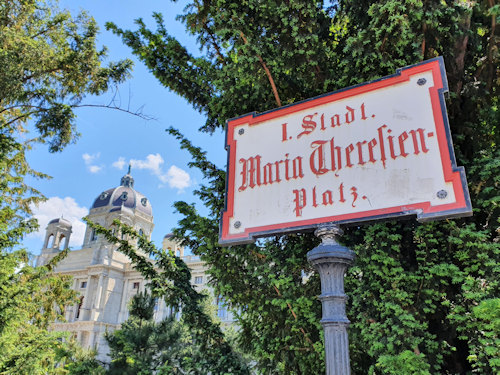
(Even the street sign has an Olde World charm)
And so our journey around Vienna’s historical squares takes us to Maria-Theresien-Platz. Though, as it turns out, this impressive-looking square is not quite as historical as you might believe.
For much of the city’s history, this area formed one section of an extensive ring of relatively open ground in front of Vienna’s fortifications. The so-called glacis stayed free of permanent buildings so city defenders would have a clear sight of any besieging enemy.
Military matters eventually evolved sufficiently to make such considerations irrelevant by the mid-19th century.

(The square’s central monument with the Kunsthistorisches Museum behind)
All that space also had planners, monarchs, business folk and aristocrats salivating at the possibilities.
So the fortifications came down, and the glacis opened up for development.
The authorities had ambitious plans for all this fresh real estate. They created, for example, the Ringstrassen boulevards of today, flanked by numerous prestigious buildings and one town palais after the next.
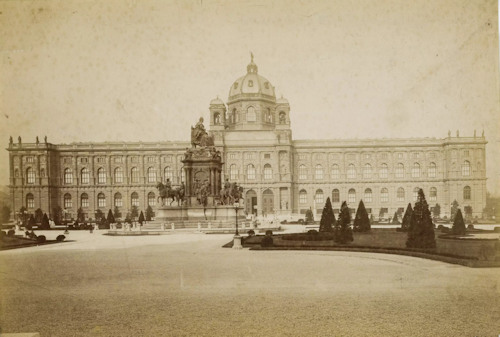
(Maria-Theresien-Platz, view of the front façade of the Naturhistorisches Museum around 1890 in a photo published by Gerlach & Wiedling; Wien Museum Inv.-Nr. 229522; excerpt reproduced with permission under the terms of the CC0 licence)
Land opposite the Hofburg palace was earmarked for Maria-Theresien-Platz: a suitably fine-looking square and buildings that would form an integrated complex with the Hofburg and Heldenplatz square.
Maria-Theresien-Platz did fulfill much of that original premise, but a lack of time, money, and (after WWI) a monarchy meant the wider integrated project never saw the light of day.
The photo above shows the square in its near-virginal state, and little has changed since construction.
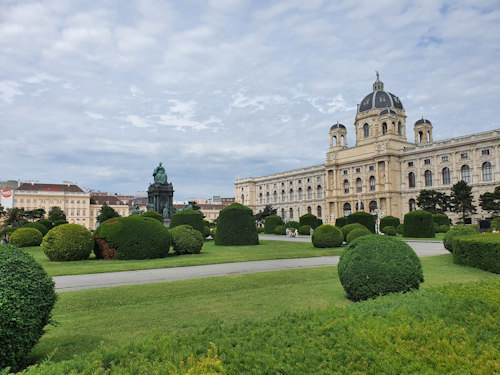
(View of the Naturhistorisches Museum and the Maria Theresa monument today. The building at the back on the left is the MuseumsQuartier)
A huge Habsburg monument to the square’s namesake sits at the centre, flanked by two magnificent museums and surrounded by a handful of fountains just to add that watery je ne sais quoi to proceedings.
As for that name, it honours Empress Maria Theresa (1717-1780), who inherited a Habsburg mess and laid the foundations for the dynasty’s success and survival into the early 20th century.
The square now forms part of many a visitor’s walking tour of Vienna (Céline and Jesse also wander through it in the movie Before Sunrise), but its big moment comes at the end of the year.

(Advent lighting, at least when we have no energy crisis)
From around mid-November, Maria-Theresien-Platz plays host to the Weihnachtsdorf Christmas market.
This market definitely ranks as one of Vienna’s biggest. And one of its prettiest, thanks to the tasteful lighting and the location with the museum backdrops.
Let”s have a look at the main features of the square in detail…
The Maria Theresa monument
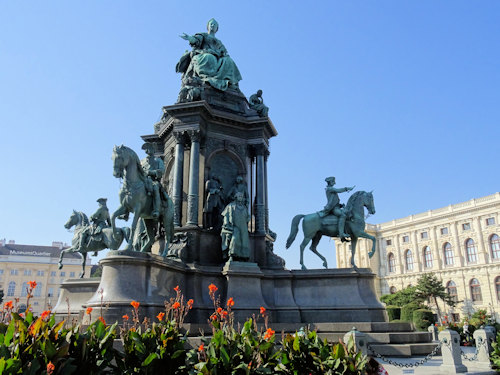
(The horsemen are all senior military men of the time)
Construction work on the area stretched across much of the second half of the 1800s, and the unveiling of the centrepiece monument took place in 1888.
The Empress herself towers over statues and reliefs of military leaders and other personalities from the fields of art, science, public administration, and more. Haydn and Mozart make an appearance, for example.
Naturhistorisches Museum

(Opened in 1889)
The two museums on the square were conceived as twins. The imperial-royal Naturhistorisches Hofmuseum (today’s Naturhistorisches Museum) was completed first.
This new Natural History institution brought together various state collections under one roof and has its own connection to Maria Theresa.
The empress’s husband, Franz Stephan (1708-1765), pursued various scientific interests, and she gave his private collection to the state after his death to form the foundation of the museum’s own archives today.
The square and museum actually play themselves in an outdoor scene from the film, Corsage, when a welcome reception greets Emperor Franz Joseph and Empress Elisabeth.
The Kunsthistorisches Museum

(Opened in 1891)
The second museum was the imperial-royal Kunsthistorisches Hofmuseum, now simply the Kunsthistorisches Museum.
The museum houses paintings by old masters and the world’s most important collection of Bruegels, as well as artifacts from ancient Egypt, Greece and Rome, the astonishing Kunstkammer chamber of wonders, and more.
Like its sister building, the insides are quite extraordinary. A young Gustav Klimt even worked on some of the motifs around the staircase.
Fountains
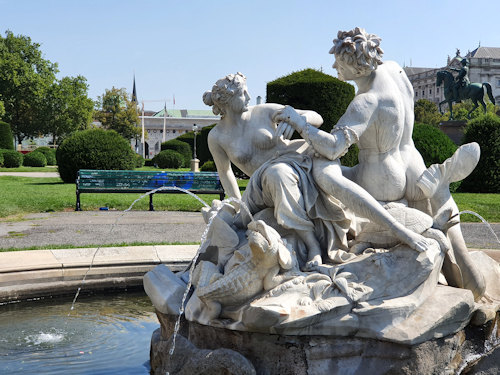
(You can never have too much Greek mythology)
Finally, four fountains with tritons and naiads surround the monument to Empress Maria Theresa and were completed just after both museums opened.
The two nearest the Ring are by Anton Schmidgruber, the others by Hugo Haerdtl and Edmund Hofmann von Aspernburg. All three sculptors produced various works for the buildings that sprang up around the Ringstrassen.
How to get to Maria-Theresien-Platz
Since it adjoins the Ring, the square has prominent subway and tram connections.
Subway: take the U3 to Volkstheater, leave the platform on the city centre side, and follow the museum signs. The MuseumsQuartier station on the U2 also offers nearby access.
Tram: take the 1, 2, D or 71 trams to either the Ring/Volkstheater or Burgring stops.
Address: Maria-Theresien-Platz, 1010 Vienna